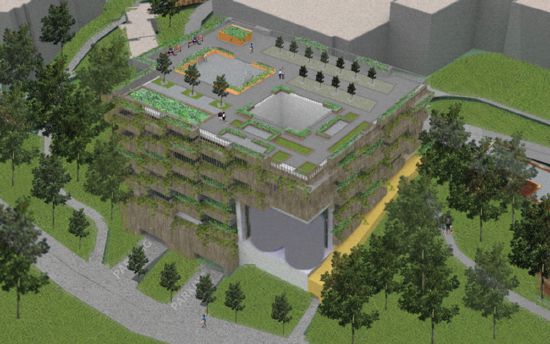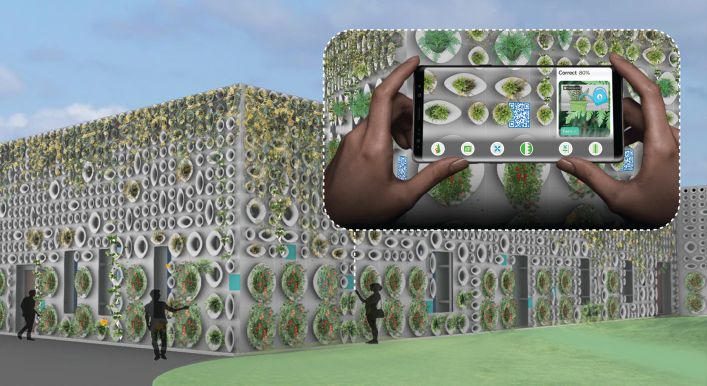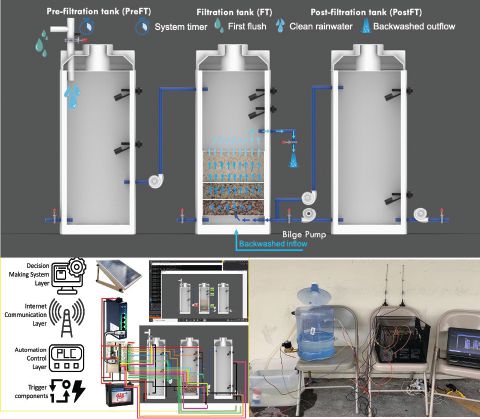Lessons Learned from Campus RainWorks 2020 Winners

The University of Pennsylvania redesigned a K-8 campus in West Philadelphia with green infrastructure, raised garden beds and a food forest.
At college and university campuses throughout the United States, students compete in the Campus RainWorks Challenge, an annual green infrastructure design challenge from the Environmental Protection Agency (EPA) to create innovative stormwater management techniques. In so doing, the challenge engages the next generation of environmental professionals whose work showcases the environmental, economic and social benefits of green infrastructure practices.
A School Redesign
Taking first place in the demonstration project category for 2020, a team at the University of Pennsylvania redesigned a local K-8 school campus in West Philadelphia to incorporate a variety of green infrastructure practices, raised garden beds and a food forest. In choosing a school site, the team conducted a comprehensive analysis of impaired watersheds in Philadelphia, healthy food access data, U.S. Census data and physical environmental information to pinpoint which neighborhoods were most in need of such a project.
“The school we chose is in a highly impaired watershed; a food desert; a high-poverty, low-income neighborhood of color; and one of the hottest ZIP Codes in Philadelphia,” notes Corey Wills, a dual-degree master’s student in environmental studies and city planning at the University of Pennsylvania, and a watershed resource analyst at the Water Center at Penn.

Nusrat Jahan Nipu

Michael Shuey
Renderings show a bird’s-eye perspective of the proposed design for the UT-Arlington health science quarter (top) as well as a phasing development plan (bottom).
In addition, stormwater from the school drains into a Combined Sewer Overflow (CSO) draining west of the neighborhood into an area susceptible to flooding and pollution.
“It’s a compendium of environmental inequities we addressed with the design,” adds Wills.
The school leadership was enthusiastic about using school property as a learning opportunity for the students.
“The principal was very focused on becoming a food hub for the community to address the fact that it is in a food desert,” she notes. “That was his No. 1 priority, which is not normally a priority in stormwater infrastructure design.”
The team turned to the Philadelphia Orchard Project—which works to develop food forests—for help identifying plants that are safe for use in rain gardens because they can absorb stormwater without taking up pollutants, making them safe for consumption.
Funding now is underway for the project, which thus far has enabled the team to hire a garden manager—in collaboration with the Netter Center for Community Partnerships—and maintain the garden space and permaculture food forest, co-designing the site with the Philadelphia Orchard Project.
The school’s capital-improvements office is finalizing the design for the rain garden component and subsurface detention basin under the parking lot. The students were expected to have an immediate opportunity to engage with raised beds.
Community input has been invaluable, notes Wills, adding that the project’s development strategy encompassed curriculum development and polling of the school’s students about what they would like to see grown in the spaces; what food sovereignty means to them; and introducing the concept of watersheds and the role of water in urban sustainability and resilience.
The idea of environmental justice and its impact on the childrens’ lives is another key component. “We’re working with the community to get this off the ground and maintain the space,” she says. “We want this to remain a community asset and not just be a one-off project, but rather an ongoing initiative that benefits both the students and the surrounding community in perpetuity.”
Contain, Clean and Connect
The University of Texas at Arlington is typical of the Dallas/Fort Worth Metroplex urban sprawl, with the city’s watersheds frequently taxed due to the highly seasonal climate. Short, intense rainfalls paired with large areas of impervious surfaces have caused devastating flash flooding.
University of Texas Arlington took two awards in the 2020 EPA Campus RainWorks Challenge, including first place in the master-plan category. The projects were completed as part of the Urban Landscape Graduate Design Studio in the Landscape Architecture Program at the College of Architecture, Planning, and Public Affairs during the 2020 fall semester, with Taner R. Ozdil, associate professor of landscape architecture, serving as faculty adviser.
“The Path Forward: Contain, Clean and Connect” equipped students and the community with innovative, resilient, and sustainable green infrastructure and climate-responsive design and management solutions, explains Ozdil.
“The project focused on improving a portion of campus with low-impact development (LID) strategies and techniques where there were design intervention needs for streetscapes, surface parking, building footprints and green infrastructure,” he says.
Not only were the projects focused on improving the campus master plan, but also using the campus grounds as a learning lab for contemporary design practices, technologies and know-how about state-of-the art landscape and stormwater management techniques.
Teams documented and analyzed regional, city, campus and site-level abiotic, biotic and human conditions and factors shaping the growing urban campus. Students identified areas of interest to help meet the campus master plan as well as provide the best environment to showcase innovative and resilient green infrastructure solutions.
Landscape-performance case studies suggest integrated LID strategies combined with climate-responsive design and carefully crafted landscape programming solutions can produce critical value to its site, community and region.
“Although some of these interventions may have a higher initial cost, such solutions have combinations of economic, social and environmental benefits that exceed the functions of conventional engineered stormwater management systems,” notes Ozdil.
To address site stormwater runoff, the team targeted four major areas for intervention: streetscapes, surface parking, building footprints and Tradinghouse Creek.
Major roads within the site are lined with bioswales. Each intersection will have adjacent rain gardens to capture, clean and release stormwater into the groundwater system before it reaches the creek. Rain gardens play a central role in parking areas.
A pedestrian bridge is designed to create an experiential journey with science-related educational programs. Building tops within the site are targeted for solar-panel placements. Rainwater will be diverted to underground cisterns to reduce irrigation costs and serve as a useful resource during long periods of drought.
A terraced detention wetland—complete with an amphitheater and boardwalk—will provide additional storage for stormwater events, habitat for local wildlife and a natural amenity for students during the dry seasons.
“We do not need any magic to change the environment,” notes Nusrat Jahan Nipu, a graduate in 2021 now pursuing a Master’s degree in landscape architecture. “We just need to raise the awareness and eagerness in what we have in ourselves already to implement our design ideas to save nature.”




A series of images illustrates the integrated stormwater plan at the University of Pittsburgh Oakland Campus.
Team PreciPITTation
The University of Pittsburgh’s “Team PreciPITTation” took second place in the master-plan category by integrating multiple green infrastructure practices into a master-plan design focused on combined sewer overlow (CSO) eliminations. The team created a design to manage stormwater runoff and reduce flooding while creating safe, multifunctional spaces accessible to students and the Pittsburgh community.
The diverse urban terrain of the University of Pittsburgh Oakland Campus (Pitt) offers ideal opportunities for planning and implementing sustainable stormwater management practices. Additionally, the COVID-19 pandemic “has shown us as a country we need more quality outdoor areas and green space as people have flocked to these locations as a means of relief,” the team notes in its project description.
“The driving factor in doing this project was to explore the university’s goals set forth in the Pitt Sustainability Plan and 2019 Pitt Institutional Master Plan draft, and investigate ways we could orient our campus goals to be more stormwater-focused or provide creative and informed avenues to reach the proposed goals,” notes Brandon Brewster, University of Pittsburgh class of 2022, facilities management sustainability intern and an environmental science major who holds certificates in sustainability and GIS.

An augmented-reality app overlays and communicates the vegetation, water use and sustainability efforts of the project to the campus community.(Florida Atlantic University)
The campus is challenged by increasing precipitation events, a worsening of the region’s CSO problems and stagnation in reaching sustainability goals in its sustainability plan. The team took an indepth look at three sites with unique campus features, making large-scale conversions to green infrastructure or LID.
The student team produced key solutions to address goals such as impervious-to-pervious diversion, increases in urban canopy and water conservation, and reduction in campus contribution to CSOs. Solutions include an initial phase of demonstration gray-water storage retrofits designed to catch rainfall from rooftops—not only providing the benefit of a pervious surface, but also introducing water reuse to water-dependent buildings. The team also established standardized tree-pit specs with stormwater built into the design.

An image details the remotely operated and self-cleaning rainwater system.
“We all felt this project was a great chance to test what we have learned at Pitt and an opportunity to explore all these different stormwater-focused infrastructures,” says Brewster.
Because the University of Pittsburgh is in the approval process with a new institutional master plan, the team wanted to work within those constraints of where the university is headed and what is reasonable according to current construction plans and institutional goals.
“From that frame of reference, we worked to provide solutions that benefited the university and surrounding region in terms of stormwater mitigation, but we also wanted to focus on the students and how our campus could become more unified, useable and beautiful,” he says, adding the team regarded the approach as providing the greatest benefits.
“Projects like these are invaluable,” adds Brewster. “They help us build on or even move beyond the traditional practice and let everyone have a say in what the campus should look and function like while still providing multiple ecosystem services. After all, isn’t that the magic of green infrastructure?”
Smart Green Infrastructure
In an effort to create a climate-resilient campus, the team at Florida International University (FIU) in Miami-Dade County targeted water-efficiency issues at the campus engineering center for its demonstration project, which took second place.
FIU has two campuses and an Engineering Center (EC) that rely on evaporative cooling towers and central chillers to maintain temperature and humidity inside buildings. Based on the team’s interaction with the FIU facilities, “we learned that FIU uses more than 14 million gallons of utility-supplied water per year to make up for the evaporative losses in the campus chiller plant with an annual cost of more than $130,000,” notes Linlong Bian, a Ph.D. student of Water Resources Engineering.
The evaporative cooling towers consume more potable water than any other type of use at the university. All area water is supplied by wells in the Biscayne Aquifer, which is adversely affected by saltwater intrusion from population-driven pumping drawdown and sea-level rise.
Water losses from evaporative cooling in the towers increase the concentration of minerals in the water system loop, causing scaling that decreases the heat exchange’s effectiveness and damages equipment. Freshwater must be added to the cooling-tower water-system loop to compensate for that. Part of the water in the cooling tower needs to be drained to decrease the concentration of minerals.
“We also noticed that the EC lacks green aesthetic areas and is prone to localized flooding,” says Vivek Verma, a Ph.D. student of Water Resources Engineering.
The FIU team collected data such as cooling-tower water consumption, meteorological data, and catchment area and pollutant concentration. A series of rainfall runoff, water quality and infrastructure thermal analyses were performed. Based on the analyses, potential solutions were depicted. The effectiveness of the solutions was quantified to address the identified campus challenges.
The demonstration project’s top three objectives are: 1) use rainwater for cooling-tower water makeup, reducing stormwater runoff on campus; 2) implement smart green roofs and green facades to mitigate the heat-island effect and promote carbon sequestration; and 3) decrease the temperature inside the building to save the campus electricity usage.
“The analysis and solutions had an iterative approach,” Bian points out.
Remotely operated and self-cleaning rainwater harvesting systems capture rainwater from solar-panel canopies. Green infrastructure such as green roofs and green facades reduce demand for potable water and electricity at the EC while also improving campus aesthetics and promoting carbon sequestration.
The project’s implementation is expected to significantly reduce campus demand for potable water and electricity without compromising the cooling tower’s performance and the comfortable temperature inside the building.
“The proposed solutions are novel and cutting edge,” says Verma. “We used IoT and VPN technology to remotely operate our rainwater harvesting system and provide a self-cleaning system. Overall, the proposed smart green infrastructure can reduce localized flooding, reduce water consumption for the evaporative cooling tower, and showcase the benefits of green infrastructure to the south Florida community.”
At a broad level, according to Bian, the proposed solution encompasses all five International Monetary Fund Sustainable Development Goals pillars: people, prosperity, planet, peace and partnership.
About Carol Brzozowski
Carol Brzozowski is a freelance journalist specializing in technology, resource management and construction topics; email: [email protected].


